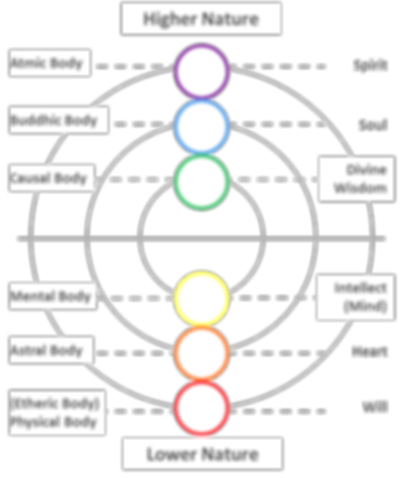Body & Soul

Everywhere, on every level of the universe, matter contains energy, and the human being’s material, physical body possesses its own specific energy. It is this energy that we call the soul.
But above and beyond their physical bodies, humans have other, subtler bodies, and each one of these subtle bodies possesses its own soul. The vital soul belongs to the physical body; the emotional or sensitive soul belongs to the astral body; the intellectual or rational soul belongs to the mental body, and the three higher bodies—causal, buddhic, and atmic—possess three higher souls.
Each body, therefore, contains its soul: the body is the form or container, and the soul is the energy that animates it. The two cannot be separated.
Nature itself, the cosmos as a whole, is a body—the body of God—and its soul is the universal Soul.
Lower Nature & Higher Nature

The three fundamental activities characteristic of humans are thought (by means of the intellect or mind), feelings (by means of the heart), and action (by means of the physical body). You must not think that only the physical body is material; the heart and mind are also material instruments, but the matter of which they are made is far subtler than that of the physical body.
This trinity, made up of our physical, astral, and mental bodies, constitutes our imperfect human nature. The three faculties of thought, feeling, and action also exist on a higher level, with their vehicles being, respectively, the causal, buddhic, and atmic bodies, which make up our divine self.
In this diagram, the three large concentric circles indicate the relationships that link the lower and higher bodies. The physical body, representing strength, will, and power on the material level, is linked to the atmic body, representing divine power, strength, and will.
The astral body, representing our egotistical, personal feelings and desires, is linked to the buddhic body, representing divine love. The mental body, representing our ordinary, self-serving thoughts, is linked to the causal body, representing divine wisdom.
In our lower, earthly self, therefore, we are a trinity that thinks, feels, and acts. But this trinity is only a very inferior reflection of that other, heavenly trinity waiting for us to become one with it.
The Two Trinities of Human’s
Higher and Lower Natures
The three lower bodies correspond to the personality, and the three higher bodies to the individuality (or Higher Self). Man possesses two natures, both of which have the power to act, to feel, and to think, but on two different levels: the personality on a lower level and the individuality on a higher level.
In reality, these two natures are not separated from each other. As you can see from the concentric circles in the diagram, each of the lower bodies is linked to the corresponding body on the higher level: the physical body is linked to the Atmic body, the astral body to the Buddhic body, and the mental body to the Causal body. This is precisely the goal of human evolution: the incarnation of each of the higher bodies in the corresponding lower body, so that man is illumined by the divine nature within him.
The line between the lower and the higher bodies represents consciousness; it is like a screen between the personality and the individuality on which both natures are reflected. If it is too limited, it means that we ourselves will be limited in our activity.
Source: Omraam Mikhaël Aïvanhov

